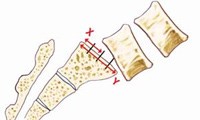Minimally Invasive Spine Surgery for Spondylolisthesis
A spondylolisthesis occurs when one vertebral body slips forward over the one beneath. There are two types: degenerative spondylolisthesis and isthmic spondylolisthesis. Most patients with a spondylolisthesis respond well to non-operative treatment, such as medication, physical therapy, and spinal injection therapies.
When to consider surgery for spondylolisthesis?
- Vertebral slip progressively worsens
- Spinal instability develops
- Pain and symptoms cannot be non-surgically managed
- Neurological dysfunction occurs
- Bowel or bladder dysfunction develops
Surgical procedures for spondylolisthesis
Your neurosurgeon may recommend a minimally invasive spine surgical (MISS) procedure instead of traditional spine surgery. The goals of either MISS or traditional spondylolisthesis surgery include: reduce nerve compression (this is called decompression) and stabilize the lumbar spine. Spinal fusion and instrumentation are performed to stop the vertebral body from sliding further forward and holds the spine in place while you heal (vertebral bodies fuse together).

(Above) The last lumbar vertebra (L5) has slipped forward over the top of the sacrum (S1).
Potential benefits of MIS for spondylolisthesis:
- Incisions are tiny or skin punctures
- Skin and muscle damage is minimized
- Your surgery may take less time
- Less blood loss
- Less pain after surgery
- Shorter hospital stay
- You heal faster
- Return to normal activities sooner
- Smaller scars
Many spine surgical procedures are performed using minimally invasive technologies. Your neurosurgeon will discuss the best option to treat your spondylolisthesis. Procedures include:
- Anterior lumbar interbody fusion (ALIF)
- Axial lumbar interbody fusion (AxiaLIF)
- Direct lateral lumbar interbody fusion (DLIF)
- Image Guided Spine Surgery
- Lateral Lumbar Interbody Fusion (XLIF)
- Posterior lumbar interbody fusion (PLIF)
- Transforaminal lumbar interbody fusion (TLIF)
Before your spondylolisthesis MIS procedure
Well in advance of your surgery day, your neurosurgeon explains how he performs your procedure. During the discussion, you learn if your procedure can be performed as a minimally invasive spine surgery or open approach, and why.
Before surgery, you visit your primary care doctor and/or other medical specialists (ie, heart doctor, endocrinologist) to obtain a general health clearance. This means your doctor has carefully evaluated your health in terms of undergoing surgery. Your assessment may include blood tests, x-rays or other imaging studies, as well as special tests for existing medical problems (i.e., diabetes, osteoporosis).
Review potential benefits and risks of spondylolisthesis surgery
Of course, the potential benefits of the surgery are important to know, but so are the possible risks and complications. Your risks and complications may be different from those of another patient because you are unique. Your neurosurgeon takes that into serious consideration and thoughtfully explains potential risks to you, which may include infection, bleeding, reaction to anesthesia, and nerve damage.
After spondylolisthesis surgery
You are moved from the operating room into the recovery area. Here, the nurses and medical staff closely monitor your vital signs with attention to managing post-operative pain. You should expect some discomfort.
Post-operative care for spondylolisthesis
Your surgery is over, but now your recovery starts! If you do not understand your post-surgical instructions or a problem develops, please call us-we are here to help you.
Conventional post-spine surgery instructions
- Schedule your post-operative appointment call (281) 446-3876
- If your doctor prescribes a lumbar brace, wear it as prescribed
- Keep your incision(s) dry and clean
- If showering is permitted, keep your incision(s) covered and dry
- Rest; you will fatigue easily while your body heals
- Do not take a tub bath, go swimming, or sit in a hot tub or pool
- Begin physical therapy and/or exercise as instructed
- Take medications as prescribed
- Do not lift or carry anything heavier than a shoe
- Walking is encouraged
- Do not drive until cleared by your neurosurgeon
- Avoid riding in a car; short distances are permitted
- Do not smoke or use tobacco
- Eat well, your body needs nutritious food to heal
Call your neurosurgeon’s office (281) 446-3876
- Fever 101 degrees Fahrenheit or higher
- Redness and/or swelling around the incision site expands
- Change in the amount, odor or appearance of the incision drainage
- Incision pain increases
- Bowel or bladder dysfunction develops
- Genital area numbness develops
Talk with your neurosurgeon
We hope this information about spondylolisthesis surgery has answered your immediate questions. Remember, your neurosurgeon is your most valuable source to answer your questions about symptoms, treatment and your healthcare.
You can learn more about minimally invasive surgery for spondylolisthesis from the following sources:
|






